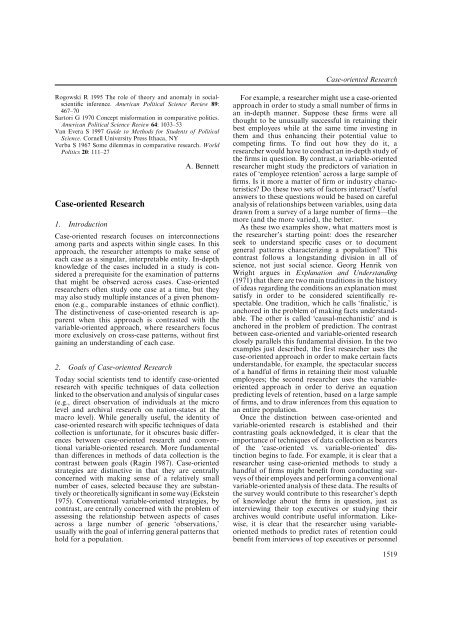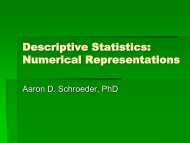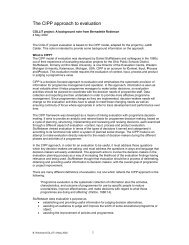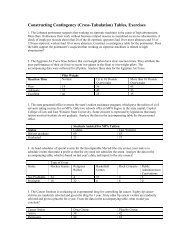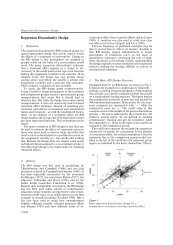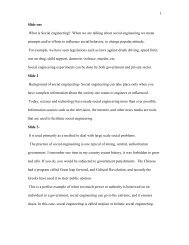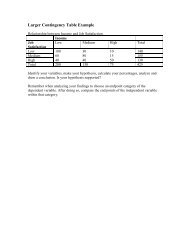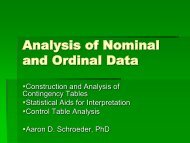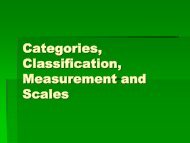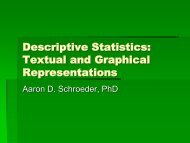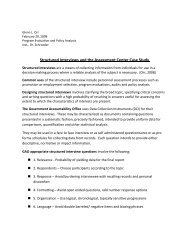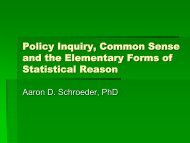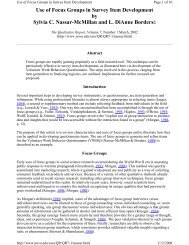Case Study: Logic
Case Study: Logic
Case Study: Logic
Create successful ePaper yourself
Turn your PDF publications into a flip-book with our unique Google optimized e-Paper software.
<strong>Case</strong>-oriented Research<br />
Rogowski R 1995 The role of theory and anomaly in socialscientific<br />
inference. American Political Science Reiew 89:<br />
467–70<br />
Sartori G 1970 Concept misformation in comparative politics.<br />
American Political Science Reiew 64: 1033–53<br />
Van Evera S 1997 Guide to Methods for Students of Political<br />
Science. Cornell University Press Ithaca, NY<br />
Verba S 1967 Some dilemmas in comparative research. World<br />
Politics 20: 111–27<br />
<strong>Case</strong>-oriented Research<br />
1. Introduction<br />
A. Bennett<br />
<strong>Case</strong>-oriented research focuses on interconnections<br />
among parts and aspects within single cases. In this<br />
approach, the researcher attempts to make sense of<br />
each case as a singular, interpretable entity. In-depth<br />
knowledge of the cases included in a study is considered<br />
a prerequisite for the examination of patterns<br />
that might be observed across cases. <strong>Case</strong>-oriented<br />
researchers often study one case at a time, but they<br />
may also study multiple instances of a given phenomenon<br />
(e.g., comparable instances of ethnic conflict).<br />
The distinctiveness of case-oriented research is apparent<br />
when this approach is contrasted with the<br />
variable-oriented approach, where researchers focus<br />
more exclusively on cross-case patterns, without first<br />
gaining an understanding of each case.<br />
2. Goals of <strong>Case</strong>-oriented Research<br />
Today social scientists tend to identify case-oriented<br />
research with specific techniques of data collection<br />
linked to the observation and analysis of singular cases<br />
(e.g., direct observation of individuals at the micro<br />
level and archival research on nation-states at the<br />
macro level). While generally useful, the identity of<br />
case-oriented research with specific techniques of data<br />
collection is unfortunate, for it obscures basic differences<br />
between case-oriented research and conventional<br />
variable-oriented research. More fundamental<br />
than differences in methods of data collection is the<br />
contrast between goals (Ragin 1987). <strong>Case</strong>-oriented<br />
strategies are distinctive in that they are centrally<br />
concerned with making sense of a relatively small<br />
number of cases, selected because they are substantivelyortheoreticallysignificantinsomeway(Eckstein<br />
1975). Conventional variable-oriented strategies, by<br />
contrast, are centrally concerned with the problem of<br />
assessing the relationship between aspects of cases<br />
across a large number of generic ‘observations,’<br />
usually with the goal of inferring general patterns that<br />
hold for a population.<br />
For example, a researcher might use a case-oriented<br />
approach in order to study a small number of firms in<br />
an in-depth manner. Suppose these firms were all<br />
thought to be unusually successful in retaining their<br />
best employees while at the same time investing in<br />
them and thus enhancing their potential value to<br />
competing firms. To find out how they do it, a<br />
researcher would have to conduct an in-depth study of<br />
the firms in question. By contrast, a variable-oriented<br />
researcher might study the predictors of variation in<br />
rates of ‘employee retention’ across a large sample of<br />
firms. Is it more a matter of firm or industry characteristics?<br />
Do these two sets of factors interact? Useful<br />
answers to these questions would be based on careful<br />
analysis of relationships between variables, using data<br />
drawn from a survey of a large number of firms—the<br />
more (and the more varied), the better.<br />
As these two examples show, what matters most is<br />
the researcher’s starting point: does the researcher<br />
seek to understand specific cases or to document<br />
general patterns characterizing a population? This<br />
contrast follows a longstanding division in all of<br />
science, not just social science. Georg Henrik von<br />
Wright argues in Explanation and Understanding<br />
(1971) that there are two main traditions in the history<br />
of ideas regarding the conditions an explanation must<br />
satisfy in order to be considered scientifically respectable.<br />
One tradition, which he calls ‘finalistic,’ is<br />
anchored in the problem of making facts understandable.<br />
The other is called ‘causal-mechanistic’ and is<br />
anchored in the problem of prediction. The contrast<br />
between case-oriented and variable-oriented research<br />
closely parallels this fundamental division. In the two<br />
examples just described, the first researcher uses the<br />
case-oriented approach in order to make certain facts<br />
understandable, for example, the spectacular success<br />
of a handful of firms in retaining their most valuable<br />
employees; the second researcher uses the variableoriented<br />
approach in order to derive an equation<br />
predicting levels of retention, based on a large sample<br />
of firms, and to draw inferences from this equation to<br />
an entire population.<br />
Once the distinction between case-oriented and<br />
variable-oriented research is established and their<br />
contrasting goals acknowledged, it is clear that the<br />
importance of techniques of data collection as bearers<br />
of the ‘case-oriented vs. variable-oriented’ distinction<br />
begins to fade. For example, it is clear that a<br />
researcher using case-oriented methods to study a<br />
handful of firms might benefit from conducting surveys<br />
of their employees and performing a conventional<br />
variable-oriented analysis of these data. The results of<br />
the survey would contribute to this researcher’s depth<br />
of knowledge about the firms in question, just as<br />
interviewing their top executives or studying their<br />
archives would contribute useful information. Likewise,<br />
it is clear that the researcher using variableoriented<br />
methods to predict rates of retention could<br />
benefit from interviews of top executives or personnel<br />
1519


